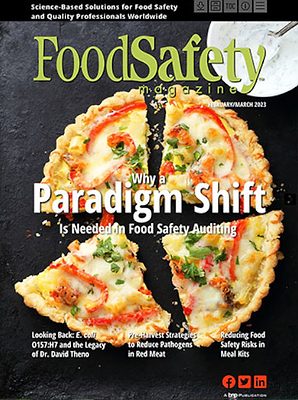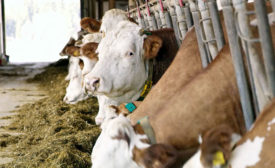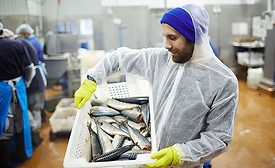Home » Publications » Food Safety Magazine
Our Publications
Please select a publication below.
Food Safety Magazine

February/March 2023
Cover Story
Back to TopThe future of food safety auditing will be different from what we know today, but the pace of change must be faster
Read More
Features
Back to TopLooking Back: E.coli O157:H7 and the Legacy of Dr. David Theno
The story of the 1992–1993 Jack in the Box outbreak is well documented, but how E. coli O157:H7 first showed up on the radar is less known
February 6, 2023
Reducing Food Safety Risks in Meal Kits
In the lack of specific regulations, businesses that are involved in meal kits have a responsibility to minimize food safety risks.
February 6, 2023
Pre-Harvest Strategies to Reduce Foodborne Pathogens in Red Meat Production
Many new pathogen reduction interventions have been implemented in recent years on the post-harvest side of animal-derived food production
February 6, 2023
Columns
Back to TopFood Safety Objectives: The Nexus among Preventive Controls, Validation, and Food Safety Assurance
The Food Safety Objective concept is compatible with the foundational precepts of process validation
February 6, 2023
Recent Outbreaks of Listeriosis Linked to Fresh, Soft Queso Fresco-Type Cheeses in the U.S.
Since 2000, outbreaks have been attributed to fresh, soft Queso Fresco-type cheeses made from pasteurized milk, which have been contaminated by L. monocytogenes after pasteurization
Evelyn Pereira M.P.H.
Cerisé Hardy M.P.H.
Melinda Hayman Ph.D.
Amanda Conrad M.P.H.
Alexandra Palacios M.P.H.
Stelios Viazis Ph.D.
February 6, 2023
A New Era for Food Allergen Analysis? Shifting Focus from Detection to Accurate and Precise Quantification
Method considerations and data gaps must be addressed in the shift toward quantitative, risk-based allergen management strategies
February 6, 2023
Innovation at the Intersection of Food Packaging and Food Safety
Several food packaging options have emerged that directly contribute to producing a high-quality and safe food product
February 6, 2023
How the Food Traceability Rule will Impact Food Processors—Part 1
What are food processors doing to prepare for compliance with the FDA Food Traceability Rule in 2026, and how do they see it affecting their businesses?
February 6, 2023
An Information Sharing and Analysis Center for the Food and Agriculture Sector
The food and agriculture sector is the only U.S. critical infrastructure without a threat Information Sharing and Analysis Center (ISAC)
February 6, 2023
Food Documents as Food Fraud Facilitators
Food fraud is accomplished in numerous ways, and document fraud may be one of the easiest ways for food fraudsters to operate undetected
February 6, 2023
How Food Manufacturers Have Responded to the COVID-19 Pandemic—Part 2
Six of the seven facilities assessed reported a "noticeable" or "significant" improvement in food safety culture behaviors of workers
February 6, 2023
Never miss the latest news and trends driving the food safety industry
eNewsletter | Website | eMagazine
JOIN TODAY!Copyright ©2024. All Rights Reserved BNP Media.
Design, CMS, Hosting & Web Development :: ePublishing











